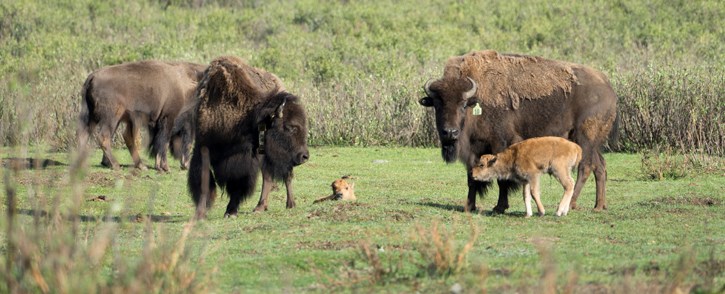BANFF – Banff’s bison herd was released from a fenced pasture into the wilds of Banff National Park on Sunday (July 29).
According to sources, the release of the bison into a larger 1,200 square kilometre reintroduction zone covering the Panther and Dormer valleys went well, although not exactly to plan.
The bison reportedly headed toward Scotch Camp, but were stopped on the Snow Creek Summit before being herded back towards the upper Panther River Valley.
Parks Canada did not provide an interview on the bison release before the Outlook went to press, other than to say teams were in the backcountry working towards final completion of the full release stage of the bison reintroduction project.
“No further information is available at this time,” wrote spokesman David Dunbar in an email.
For thousands of years, plains bison roamed the plains of North America. Their numbers were as large as 30 million, but bison nearly went extinct in the 19th Century within a single human lifetime due to overhunting and slaughter.
In 2017, 10 pregnant cows and six bulls were brought to the Panther Valley from a disease-free herd at Elk Island National Park as part of an ambitious $6.6 million reintroduction plan.
The animals were placed in an 18-hectare fenced pasture in the Panther Valley, about 40 kilometres north of the Banff townsite.
Last spring, all 10 females gave birth and all calves survived their first year. Three more calves were born this year in mid-July, bringing the herd’s size to 29.
By holding bison for two calving seasons in the fenced area in the heart of the reintroduction zone, it is hoped bison will bond to their new home range and make this their annual calving grounds.
Parks Canada doesn’t want the herd wandering onto neighbouring provincial land where they could be killed without repercussions because of a lack of legal status, or to more developed areas of Banff National Park.
To deal with this, approximately eight kilometres of adjustable fencing has been installed in 15 different locations in an attempt to keep the animals inside the larger bison zone.
GPS collars have been put on adult bison and ear tag transmitters on last year’s calves.
Monitoring the satellite collars, Parks Canada will keep tabs on bison and herd, haze, or bait them as necessary to help steer their movements to encourage them to develop an affinity within their new home range.
In 2022, Parks Canada will assess whether to continue or abandon the project.




